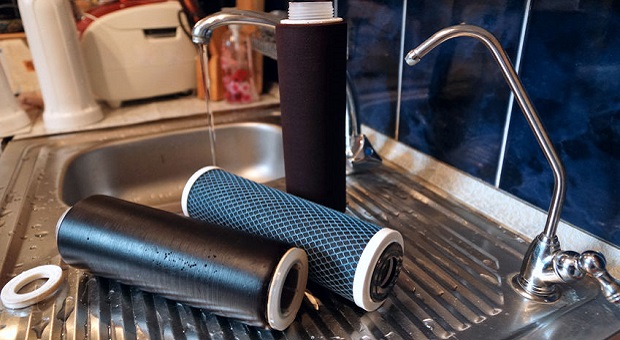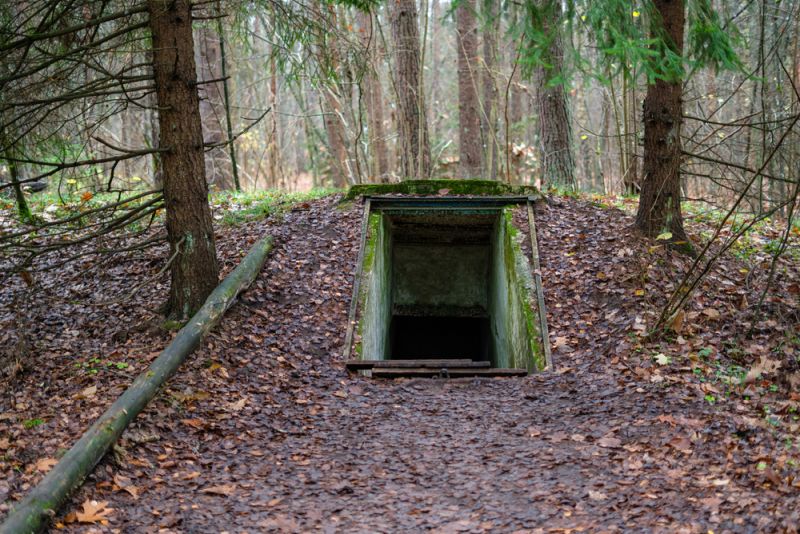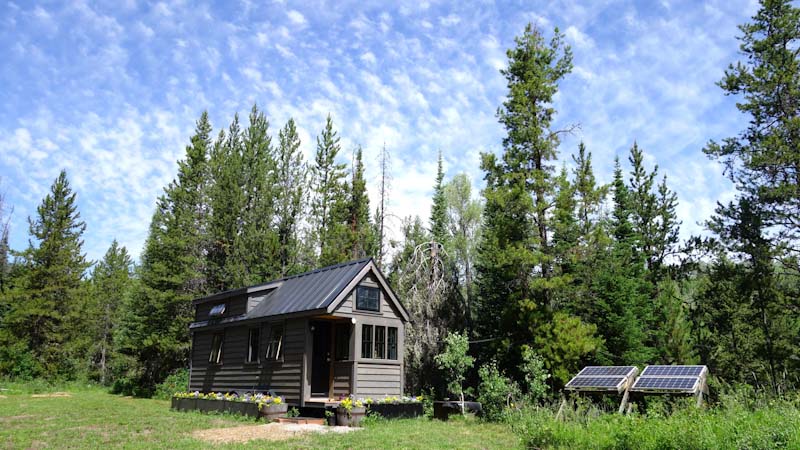There are many reasons that you may want to filter your water.
Maybe you don’t like the chemicals used by municipal treatment plants. Perhaps you want a back-up plan in case SHTF.
Regardless of WHY you want to filter your water, knowing how to choose a water filter before you invest your hard-earned money just makes sense.
Why Filter Water?
Even the clearest stream may be full of invisible protozoa, bacteria and viruses that can make you sick or even kill you. Never assume that any water source is safe just because it looks clean; most of the contaminants in water are too small to see with your eyes.
Even if it comes straight from your tap, your water may still contain harmful contaminants. Many water treatment facilities were built so long ago that they’re just not equipped to filter water properly. Pipes get old and leak and the sheer mass of pollution produced by a large city can overwhelm an aging system.
Also, many cities add fluoride to your water. The potential dangers of fluoride are a source of controversy, so many people don’t want to drink fluoridated water.
If disaster should strike, water services may go down or something may happen to make your tap water unsafe. You may even have to depend upon other sources of water to survive.
In the event of a radioactive event, the water won’t be safe to drink. In these cases you absolutely MUST filter and purify your water before you drink it.
What’s the Difference Between Water Filtration and Water Purification?
You need to understand the difference here because it’s critical to your decision. There are three types of disease-causing pathogens in water, not counting minerals and pharmaceuticals.
We published an article not too long ago about the various contaminants in water that you can read here. Here’s a basic rundown for now:
- Bacteria: Some examples that you’ve probably heard of are E. coli and salmonella. There are many more and, so that you know what filter to look for, they can be as small as 0.1 microns, though a 1-micron filter will capture 99.9% of bacteria.
- Protozoan Cysts: these are hardy little “eggs” that have an extremely hard shell. The only way to kill them is by boiling them but they can be filtered out. Examples include Giardia and Cryptosporidium. They range in size from 1-300 microns.
- Viruses: Right now, these are rarely found in American or Canadian waters but that could change quickly if SHTF. Viruses include hepatitis A and rotavirus and range in size from 0.005-1 micron. Only purification by some means can remove these from the water; filters won’t work because the viruses are so small.
Here are the different water filtration units commonly available:
- Standard water filters filter out sediment, Giardia and other large protozoa and some bacteria that may be in the water.
- Micro filters remove most microorganisms including bacteria and protozoa. You’ll still need to add a disinfectant to kill viruses. They also often remove most toxic heavy metals such as lead and fluoride.
- Water purifiers remove all microorganisms from the water, including viruses but they may not remove debris such as dirt. They may come in the form of tablets or liquid such as iodine or bleach. Distillation, boiling and desalination processes also purify water.
As you can see, there’s a big difference here. Most water filters nowadays are micro filters. Just read the micron size on the box or in the advertisement to make sure that the filter is made of material that will filter the water based upon your needs.
Thanks to modern technology and good old fashioned common sense, there are many different types of water filters and purifiers on the market.
We recommend, at the very least, using a micro filter that’s no larger than 1 micron: that will eliminate about 99.9% of the bacteria in the water. Many micro filters start at .2 microns. Of course, viruses are still an issue but there are other alternatives to that.
Video first seen on Shepherd School
What Type Of Water Filtration are You Looking For?
This is a major factor in deciding what type of filter is best.
Home Filtration Units
If you want to filter water for your entire house, we recommend using a point-of-entry system or a point-of-delivery system. The latter is going to be much cheaper and just as effective. We recommend using a reverse osmosis (RO) or distillation system if you want to filter out everything.
You can pick a really good RO system up for under the sink for about $200. The filters are about $20 but you’ll also see a hike in your water bill.
Reverse osmosis filters out the clean water and pours the excess water, or brine, down the drain. Most systems lose about 3 gallons of brine to get one gallon of fresh water.
Many people adjust for this by re-routing the brine to a bucket that they use for watering plants or other uses that don’t require purified water.
You can also get standard carbon or ceramic filter units that are just about as good as reverse osmosis, though they don’t filter out viruses and some heavy metals. Some do come with chemical components that take care of the viral worries, though.
Keep in mind that water distilled or purified using reverse osmosis lacks the minerals that you need, so find out how to re-mineralize your water in our article, here.
Refrigeration Units
You probably already know about these and may even have one in your fridge. It’s a carbon or ceramic filtration unit that holds anywhere from a quart to several gallons of filtered water.
They’re great for improving the taste of your water and removing particulates, bacteria, heavy metals and most protozoa. The most commonly known brand name for these units is Brita.
Portable Units
These consist of water bottles and survival pieces such as straws that allow you to drink directly from the water source because they filter out impurities, bacteria and some heavy metals as you drink. Most don’t filter out viruses though. Examples include the LifeStraw and Brita’s water bottles.
There are also portable bags that purify by using the UV rays in sunlight. They’re light and take up very little space; in fact, the Life Sack, currently used to purify water in 3rd world countries, doubles as a grain delivery package that is then used as a water purifier. It even has a 15nm water filtration unit at the point of exit.
Desalination Units
This is a biggie for survivalists and preppers that live along the coast. It turns salt water into drinkable water while also removing bacteria, protozoa, heavy metals, most prescription meds and even viruses.
We found a great one called the Survival Still that turns contaminated water, even salt water, into pure drinking water. The unit costs under $300 and is fairly portable.
Another upside of this unit is that it’s made in the USA with USA materials and is stainless steel so rust isn’t an issue.
And if you’re a bit mechanically inclined, read our article about how to build your own desalination still.
Basically, the type of water filter that you need depends upon what you need it for. Before starting your search, ask yourself these questions:
- Do you want a system for your house or one that’s portable?
- What do you want to use the filter for (whole house, drinking/cooking, survival)?
- If you want a portable one, how much space and weight can you allow?
- Compare what the filter removes to what you want it to remove (what is the micron rating?)
- How long does the filter last?
- Can you clean or easily replace the filter?
- How much clean water does the filter produce daily compared to what you need?
- How much water does the filter waste?
- How difficult is the filter to use or install?
- How much are you willing or able to spend?
Once you answer these questions, you’ll have a better idea of what type of water filter or purifier that you need.
If you have any other questions or suggestions for how to choose a water filter, please share them in the comments section below!









Ronald F. Bradford | May 29, 2015
|
I have been advocating the small desalinization plants for awhile now. Dig a well in the arid areas of West Texas that used to be a sea and guess what you get…yep, salt water. If one had a well and a desal plant, the soil is ripe for farming various veggies. Desal plants are also a thing of the future. Though we may have a wet season here and there, a portable desal plant aboard a renovated step van driven to the coast could haul several barrels of fresh water back home. How do I know?
I was aboard 4 aircraft carriers in during Viet Nam era. Periodically we would anchor in the harbor off the island of Hong Kong. Our port fee for our task force was 100,000 gal of fresh water, since they do not naturally have fresh water there. With today’s technology, how much better to be able to work with small de-sal plants to supply our own needs.
Rambuff | May 29, 2015
|
Not a bad article, however I disagree with the author’s use of the term: “Pure”, and “Purifier”. These terms, as used in this article, give the impression that the instrument does more than just filter, rendering the water: “Pure”, which is in NO WAY accurate. The term, as used in Industrial and Medical standards, means: “Free of impurities”. None of the units mentioned comes anywhere close to being effective in that manner.
By the way – using a “Refrigerator filter”, such as the afore-mentioned Brita, will, if filled with contaminated water, kill you via a false sense of security.
To check the efficacy of a filter, you MUST demand and compare the MSDS or specification sheet for the unit. The efficacy of a given unit can only be ascertained by extensive laboratory testing.
The “best” filters, I noted, were not even mentioned in the article – the Berkey line of filters. They are the undisputed leaders in portable, non-electric and non-pressure units that WILL keep you safe from contaminants. The only ones better, in this Engineer’s experience, are Reverse Osmosis units that are WAY more expensive than the $200 the author mentioned….more in the line of $2000.
You choose…it’s YOUR LIFE. But, as the old knight quoted in the Last Crusade: “Choose Wisely”.
Mahatma Muhjesbude | May 29, 2015
|
Hey Rambuff, as one who was fortunate enough to not be among ‘the last Knights Templars in the last Crusade’, who back then would probably be drinking recently collected rainwater, nature’s form of ‘pure’ distilled water, I have experienced some rather uncomfortable water borne ‘ailments’ in various countries around the world at one time or another, even when it was supposed to have been treated.
I made the critical survival choice to from then on drink only beer.
But my question is, since steamed distilled water is the only ‘true’ purified water and doesn’t even contain the minerals found in most clean water, and since its molecular ionic action is different than saturated H20, it even acts as a chelation element helping to remove toxins in the body, especially heavy metals. with the new compact, efficient, and affordable ones out now, especially the multi-fuel ones, it would seem to me this would be the best and most cost effective for long term base BOL water purification?
And, a distiller would be also a ‘still’ for the other ‘medications’ often needed during stressful survival activities?
So wouldn’t that be the best if you had fuel resources?
prsmith | April 6, 2016
|
I use a Berkey filtration system (mentioned earlier) for my drinking water and I use the added PF-1 filter which takes out Fluoride. It isn’t practical for a whole house filter but I recommend the added step for your drinking water is fluoridated. I won’t go into the reasons here but you might want to visit www.http://fluoridealert.org/.
prsmith | April 6, 2016
|
Sorry, no www, just http://fluoridealert.org/
prsmith | April 6, 2016
|
I would like to suggest that you NOT try to use the filter you mention for making medicinal alcohol. The fumes from an unsealed boiler like that could, and probably would, ignite.
HeR3tic | May 29, 2015
|
Rambuff promotes the Berkey line of counter top gravity fed filters. While this would be my second choice, the American made Aqua Rain filter is IMO superior. First of all, its ceramic filters are better, with much small micron size filtration and with micro fine silver partical impregnated walls*, though the rate of filtration is slower. There is the initial cost of a four element ceramic filter; then the replacement cost of each element. Aqua Rain units surpasses Berkey filters in both initial and replacement costs. *Silver impregnated ceramic filters are IMO the final defense against all bacteria and virus.
Then, if youre not totally convinced as to the absence of bacteria and virus from you filtered water, add an ounce of 10 ppm colloidal silver (CS) to the either the initial fill or final output. Laboratory tests, UC Berkley and Brigham Young studies, show 5 ppm killed all tested bacteria and virus in less than 5 minutes. It has been shown that 1 oz CS will kill all bacteria and virus in a gallon of septic tank water in very short period of time. Thats powerful!
International studies have shown CS to combat Ebola and AIDS effectively; but, you wont hear that from the Pharma Corps.
Cole Wilson | May 29, 2015
|
How do you guys rate the Sawyer water filter I bought one recently for a better to have one just in case now thinking one is none and two is one any comments or reviews would be a great help.
Great Grey | June 29, 2015
|
It depends on which one you got. 0.1 micron or the 0.02 micron the main different is the Point ZeroTWO removes 99.997% of Viruses that the PointONE filter does not and has a lower flow rate. They remove biological contaminants (is great if that is all you need to remove, neither of them will filter out chemicals or heavy metals). But removing the dirt before running the water though your chemical filter should make it last longer. However which filter you use first may depend on what kind of contaminants you have.
Use a settling tank/sand filter/homemade filter, before the store bought filters to extend the life of the store bought ones.
prsmith | April 6, 2016
|
I haven’t seen a 0.01 micron filter but I have seen 0.02 micron filters which are substantially less effective on viruses than 0.01 micron would be. I also don’t know if the smaller viruses are more or less dangerous than their larger brethren out there so be careful out there – chemicals and boiling work and boiling doesn’t run out or get clogged/broken/lost. Here’s a chart that might help: http://www.bing.com/images/search?q=water+filtration+chart+viruses&view=detailv2&&id=677F2424B1318DD819AE5068F501788BC7043398&selectedIndex=0&ccid=vF1mbpJb&simid=607988042285122153&thid=OIP.Mbc5d666e925b573389c64a0fb4ac111fo0&ajaxhist=0
Great Grey | April 6, 2016
|
You missed read what I wrote, it is (0.10) one tenth not one hundredth. It won’t filter out viruses but, the 0.02 (two hundredths) will.
prsmith | April 6, 2016
|
The 0.02 micron will NOT filter out all viruses – only about 60% of them. Boil your water to be safe.
Felix | May 29, 2015
|
Nice article, but for me, one person household, I just bought a hand model
Clearly Filtered, maybe 3 quarts, I use for morning coffee and drinking. It is on the net with credible credentials called www,clearlyfiltered.com I replace the filter every month = 200 gallons
FLAME | May 29, 2015
|
The article says: “Reverse osmosis filters out the clean water and pours the excess water, or brine, down the drain. Most systems lose about 3 gallons of brine to get one gallon of fresh water. Many people adjust for this by re-routing the brine to a bucket that they use for watering plants or other uses that don’t require purified water.”
My understanding of “brine” is that it is SALT water. My inland city water system should not produce brine at all, and since too much salt will kill plants, I would not want to re-route brine to a garden—except maybe to finally get rid of a particular invasive vine that’s driving me nuts.
Further reading in the article suggests that this stovetop/campfire still is popular along the coasts where salt water is common. Therefore,I hope that the writer did not intend to suggest that those 3 gallons of water thrown off by the RO process are always salty.
This loss of 3 gallons to gain 1 gallon of purified water is a major reason I did not install RO at this house, but if I can re-route the 3 gallons to other uses, such as car washing and garden, or even store it for use in the Survival Still shown, I might rethink the earlier decision.
Ric Wesrson | May 30, 2015
|
If you are considering thetreatment of a fixed water supply, eg a piped, borehole or well supply, and it is at least 3 bar pressure, the most effective system is Ozonation. It is vastely superior to Reverse Osmosis (RO). Ozone not only kills all microbes, it also breaks down all long chain molecules (eg benzyl rings etc) and causes heavy metals (eg cadmium, Uranium) to come out of solution. I have not read any literature on it, but it will probable break most (possibly ALL) fracking chemicals!
It can therefore be used to treat both polluted suface and groundwaters; you just need enough pressure to drive the system. You also need electrical power, since the ozone is generated by spark; similar to lightning. Plants vary in size from city supply down to single taps.
Ensure that the water is filtered of particulate matter. [the more muck is filtered out, the less ozone is required to treat the water] pass the water through the ozonator, then a sellting tank to allow some of the metals to settle out and then pass it through an activated carbon filtre.
The AC filtre is essential since it is a medium that filters out particulate matter, and it is ia medium that allows broken down complex molecules (those nasty poisonous chemicals) to be adsorbed. The pressure needs to be high to force the water through these AC filters.
This technology is ready available in Europe, South Africa and Russia; so it should be available in the States.
I am an Earth & Water scientist in Africa who has been involved in urban and rural development and environmental protection, and if I lived in a fracking, irradiated or other chemically or biologically polluted area, this is the technology that I would for my personal household supply.
Oh yeah, I have no shares in any organization that manufactures or supplies ozonation equipment.
David E. Minigh | June 14, 2015
|
Good article and very informative as well. I researched this subject very much in the past year or so. Found a new product on the market by PUR. It is a two stage filter that is a Dispenser(but the filter is only good for 40 gallons) and removes 99.9% of the cysts, etc. BUT to finalize your purification process, use UV in the 254 nanometer range(such as the Steripen) to finish off the left over cysts. Use the UV device before, RIGHT BEFORE you use the water you hav filtered. WHY, you ask. I discovered ha once the cysts left over are exposed to light, they have developed the ability to repair themselves. Their DNA has evolved this over he millennia. Thought you should know.
Paul Smith | November 10, 2015
|
Thank you for pointing out that the LifeStraw Personal water filter does not filter out viruses. So many people have bought these dangerous filters and keep them in their bug-out, get-home bags. . .in a SHTF scenario, so many people will die 🙁
Kenneth Gladman | April 5, 2016
|
We are looking for a good home filtration system. We have been researching and apparently there are some dangers of drinking tap water. I think it would be worth our investment to have filtered water. Thanks for the recommendation on a port of entry system. We will have to look into possibly a reverse osmosis system.
Pingback:Help – It’s Illegal to Live Off-Grid! | Survivopedia | October 16, 2016
|
John Mahoney | February 23, 2017
|
Thank you for talking bout the importance of making sure your water is properly filtered and purified. It makes sense that getting quality water can help your body function properly and get the minerals it needs. I can see that making sure you choose a reliable company to buy from can help you get the benefits you need.
Pingback:The Ugly Part of Water Purification: Top 5 Mistakes You Make | Survivopedia | October 4, 2017
|